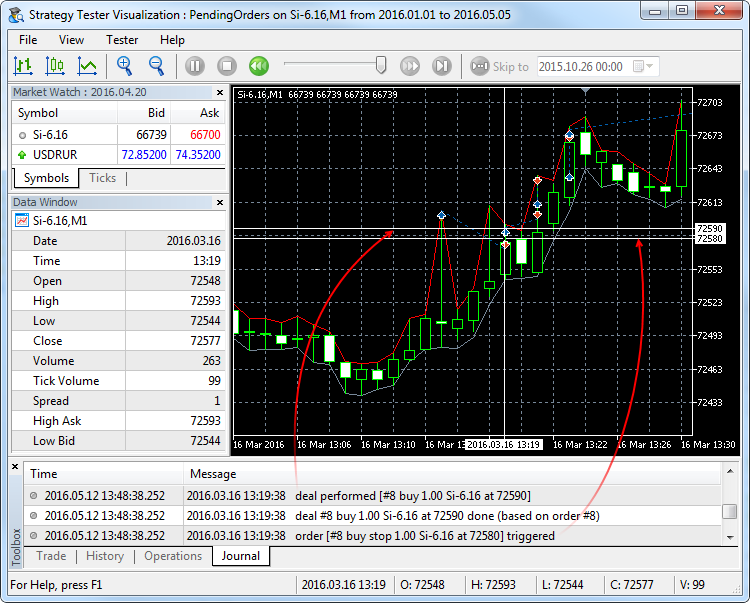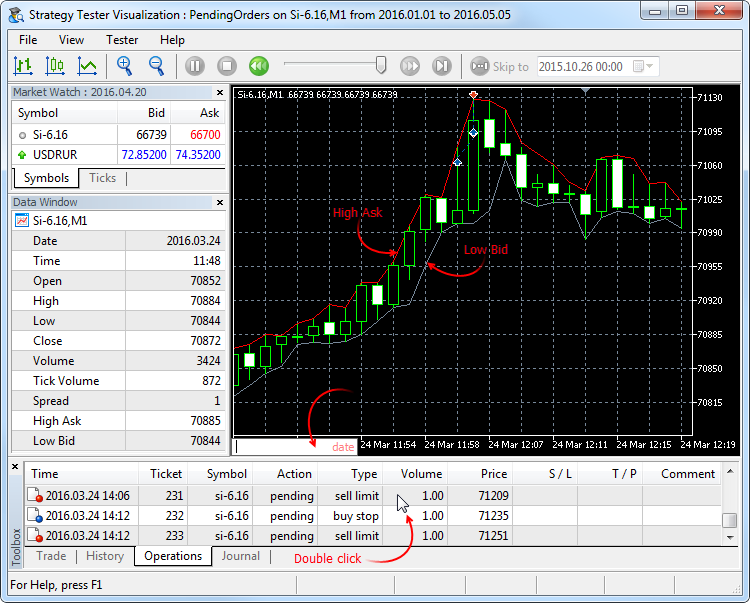You are missing trading opportunities:
- Free trading apps
- Over 8,000 signals for copying
- Economic news for exploring financial markets
Registration
Log in
You agree to website policy and terms of use
If you do not have an account, please register
You're wrong.
It's the ask that triggers the buy limit.
What are you picking on the flipper when the trigger condition is asc?
In all seriousness, you are simply illiterate.
You seem to have some sketchy knowledge and aren't trying to understand what you're told.
Forget it. )
Although, to be honest, I didn't expect to hear you say that limits are triggered by anc or bid.
Forget it. )
Although, to be honest, I didn't expect to hear from you that the limits are triggered by the asc.
Within a tester, this is correct and reasonable behaviour. Just like in the market, until a better asc comes along that reaches the bylimit price, so it is in the tester.
The correct strategy for the tester is to wait for the asc to execute the bylimit order. For the tester should hold his horses and not give unnecessary reason for self-deception, when a flipper from nowhere (it was not for you, it was not for you. and it could easily be a bid flipper) gives you a fabulous execution.
Think deeper and listen when you are explained and shown direction. There is a suspicion that you do not know what a bylimit order is.
Within the tester, this is correct and reasonable behaviour. Just as in the market, until a better asc appears(flashed) that reaches the bylimit price, so it is in the tester.
Are you serious? In the market, limit orders are executed by counter market orders. As soon as someone sells enough volume on the market to reach your bylimit, the order is filled (fully or partially). What the asc is in this case is not even a tenth of a point, it may not even matter, it may be somewhere far away.
The proper strategy for the tester is to wait for the Ask to execute the bylimit order. For the tester should hold his horses and not give unnecessary reason for self-deception, when from nowhere a flipper (it was not for you, not for you. and it can be easily a bid flipper) gives you a fabulous execution.
Think deeper.
What kind of horses? What fabulous performance? What self-delusion? Naturally, the flipper is "not for me" - for someone who is testing, no tick has ever been intended in history at all, what kind of argument is that? There is a buy limit price, someone sold out of the market so that the tick fell to that price or lower, in reality it would lead to the execution of the limit (although if the price reached strictly to the buy limit price, not a fact, but if it fell below, then for sure). And the bylimit is activated only in the brokerage house.
SZZ. No, not only in DC, also in aggregators that broadcast to their terminal the aggregate stream of different suppliers. But this is about forex, not about the exchange.
Are you serious? In the market, limit orders are executed by counter-market orders. As soon as someone sells enough volume on the market to reach your limit, the order is filled (fully or partially). What kind of ask is not even a tenth thing, it may not even matter, it may be somewhere far away.
What kind of horses? What fabulous performance? What self-delusion? Naturally, the flipper is "not for me" - for whoever is testing, no tick in history at all, what kind of argument is that? There is a buy limit price, someone sold out of the market, so that the tick fell to that price or lower, in reality it would lead to the execution of the limit (although if the price reached strictly to the bylimit price, not a fact, but if it fell below, then for sure). And the bylimit is activated only in the brokerage house.
SZZ. No, not only in DC, also in aggregators that broadcast to their terminal the aggregate flow of different suppliers. But this is about forex, not about the exchange.
Generally speaking, the execution by bylimit ask is absolutely correct. For example, there are no flippers or there is no testing on real ticks.
And here I agree. It's not for nothing that I wrote in my comment with screenshots that it was a test on real ticks. If they are absent, the only way is bid and ask, no other way. I also wrote that the tester should not change anything in prices. That comment was caused by surprise when your employee said that a bylimit order is a buy order at ask price. It wasn't until the next page that he clarified what he meant - that it was only about a tester, that it was conditional, that it was because... etc. And I that's his explanation. Anyway, I admit - rushed it, didn't read the conversation carefully to the end, he was just being inaccurate at first.
Unfortunately moex doesn't convey thedirection of the transaction in its gateways in flipper ticks. This means that it is impossible to tell with 100% accuracy in which direction the market moved. And this is important for order triggering.
If sold down by market selling, then the price of the flipper has the right to act as a virtual asc. Conversely, when buying from the market, the flipper becomes a virtual bid, which allows sell-side orders to be triggered.In a case where there is no direction in the flipper, it is possible to predict the direction of the shift. We will do some research and perhaps we'll put in the direction ourselves.
You mean in the tester, or are you going to fill the fieldsTICK_FLAG_BUY and TICK_FLAG_SELL directly in the flow?
For history:
Forum on trading, automated trading systems and trading strategy testing
List of changes in MetaTrader 5 Client Terminal builds
MetaQuotes Software Corp., 2016.05.12 19:59
New version of the MetaTrader 5 platform build 1340: Easy migration of certificates to mobile and improvements in the tester
An update to the MetaTrader 5 platform will be published on Friday 13 May 2016. The update contains the following changes:
What has changed for exchange traded instruments
In the real market for exchange instruments the charts are plotted and stop orders are triggered at the last trade price (Last). Limit orders are triggered at Bid/Ask prices. All order types are always executed at the current market Bid/Ask prices. Changes have been made in the strategy tester to bring it more closely in line with real market conditions:
Stop, Stop Limit and SL/TP orders at Last
Let us consider an example using the Si-6.16. At the current prices Bid=72570, Ask=72572, Last=72552, a Buy Stop order has been placed with the trigger price of 72580. In the price flow we got new current prices:
In exchange instruments, the trigger for triggering of stop orders is the Last price. Therefore, arrival of the Last=72580 price in the flow has triggered a Buy Stop order. Previously, this very price of 72580 would have been used to execute this order. This behaviour was incorrect as there is no Ask=72580 price in the market to execute the Buy Stop.

The updated tester uses the current buy price Ask=72590, and the Buy Stop order will be executed there. Thus, the new algorithm of trade execution in the tester more accurately corresponds to the real market. With the old algorithm, a trade would be executed at a non-market price which would lead to incorrect test results.What has changed for OTC symbols
For OTC symbols, the triggering algorithm remains the same: the Bid and Ask prices are used for all types of pending orders and SL/TP. The execution mode has changed: previously it was done at the price specified in the order, now the current market Bid and Ask prices at the moment of triggering are used.
New features in visual testing
During visual testing, lines of the maximum Ask price and minimum Bid price per bar are now shown. It is easier to test Expert Advisors in the chart where bars are built and orders are triggered by Last prices, and market operations are executed by Bid and Ask prices.

The visual testing chart now has the ability to navigate to a specified date. Double-click on the chart and select the required date and time. In addition, you can move the chart to any order or trade: Double click on a trade on the "Trade", "History" or "Transactions" tabs.For the story:
A contradiction of sorts.
Stop, stop limit and SL/TP orders on Last
Isn't TP a limit order? And how can SL be executed at Last when the example says otherwise?
In the updated tester, the current Buy price Ask=72590 is used and the Buy Stop will be executed there. Thus, the new algorithm of trade execution in the tester corresponds more exactly with the real market. With the old algorithm, the trade would be executed at a non-market price, which would lead to incorrect test results.
This is a contradiction.
Isn't TP a limit order? And how can SL be executed on Last when the example says otherwise?
The example is about execution (filling), not execution-activation.
The order activates Last and its price will be assigned to Ask which was at that moment.
The example is about execution (pouring), not execution-activation.
Activates an order Last, and its price will be assigned to Asc, which was at that moment.
Thanks, felt the difference. But still, why does TP activate on the flipper?
And anyway, what does the history of the flipper have to do with the activation of the execution? Can anyone explain it lucidly?